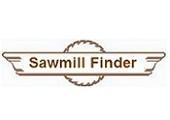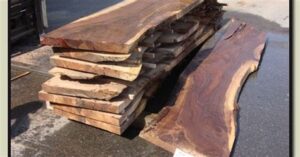Cutting With a Purpose
- Plain Sawn
- Quarter Sawn
- Rift Sawn
- Flitch Cut
Going to hiring a sawmill, or maybe your a new Sawyer? If you’re not familiar with these terms keep reading. A little information will go a long way.
How does a Sawyer choose a cutting method? Customer needs and Species of logs are the first things to consider.
Some clients have a project and cut list all planed out while others will ask their Sawyer what’s best to cut. In either case type and size of logs will contribute to deciding how and what to cut.
For Sawyers to be competitive and log owners looking to process their logs into lumber usually an overriding factor is cost.
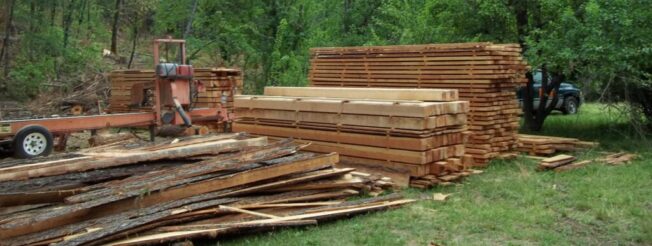
Sawing Lumber From Logs
Cutting Methods
The methods of cutting wood are determined by the intended use, appearance, and stability of the wood. There are four cutting methods, of which the first two are the most common. Plane Sawn, Quarter Sawn, Rift Sawn and Flitch Cut. Just how a log is cut into lumber has a large influence on the quality of the finished product. When a sawyer saws a log, usually the goal is to obtain the largest volume of usable wood in the shortest length of time. This results in mostly plane sawn lumber that services the high volume wood industry.
Plane Sawn
This is the simplest method. The log is squared and sawed lengthwise. Knots that occur are round or oval -shaped and have relatively little weakening effect on the lumber. The annual rings appear as approximately straight lines running across grain. The lines join at the bottom, forming a U-shape; however, this part is sometimes cut off. Wood cut this way shrinks and swells very little in thickness.
Flitch Cut
Flitch Cut refers to a board that has bark on one or both sides, also known as a slab or plank. Or can be a portion of a sawn log which is insufficient for finished lumber (due to bark or defects on one or more sides).
Rift Sawn
The logs are sawed at not less than 35 or more than 65 degrees to the annual rings, usually at about 45 degrees. In wood sawed this way, the rings appear as longitudinal lines. Rays always run longitudinally and are longer than lumber cut by the other methods.
Quarter Sawn
Quarter sawing (see diagram) produces boards cut on the radius rather than on the tangent (plane sawn). If it is softwood it is called “edge grained” or “vertical grained”. It is slower to 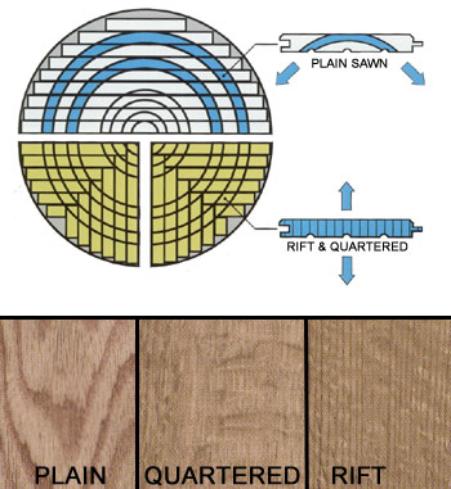 produce at the sawmill but does result in a higher quality product. The log is sawed into quarters, then into boards. The angle between the cut and the growth rings varies from 90 degrees to about 45 degrees. In such wood, the lines formed by the rings run with the grain. Again they will appear as relatively straight or as U-shaped, depending upon how much is cut off. Such lumber shrinks and swells less in width and warps less than plain-sawn lumber.
produce at the sawmill but does result in a higher quality product. The log is sawed into quarters, then into boards. The angle between the cut and the growth rings varies from 90 degrees to about 45 degrees. In such wood, the lines formed by the rings run with the grain. Again they will appear as relatively straight or as U-shaped, depending upon how much is cut off. Such lumber shrinks and swells less in width and warps less than plain-sawn lumber. 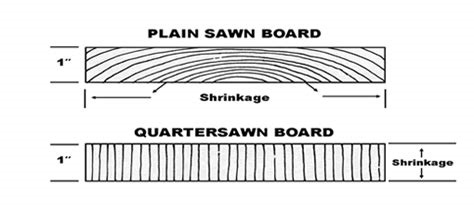
Advantages and Disadvantages of these Sawing Techniques:
Quarter sawn wood has two distinct advantages over plane sawn wood.
• Structurally it has a much higher level of dimensional stability during the drying process and its life thereafter. In other words it is much less likely to bow, warp, or twist. And it is stronger.
• In addition to the structural advantages, many species display a beautiful pattern of rays that is sought after by woodworker’s and cabinetmakers.
If you require dimensionally stable wood for glued up panels, tabletops or any cabinetwork that requires stability and beauty, quarter sawn will result in the highest quality finished products.
Plan or Flat Sawn

1. Less waste but less stable.
2. Less time cutting.
3. More shrinkage in width.
4 Less expensive.
5. Wider widths.
Quartered or Rift Sawn

1. Most waste and most expensive.
2. Most stable but narrow widths.
3. Shrinks more in thickness than width.
4. More labor intensive.
Which Method Should I use?
Well this really depends on your taste, species of logs, your project and maybe even your budget. The quarter sawn boards From an Oak tree will have the characteristic “Tiger Stripes” found only in quarter sawn lumber and will generally have less movement (shrinkage) when drying. The way the cells are aligned will cause the quarter sawn board to shrink a little bit in width and very little in thickness. Quarter sawn boards are also much less prone to warping. Plain sawn boards have grain in multiple directions, this will cause un-even drying and in turn cause the board to warp (cup, twist, and bow). The shrinkage rate is also much more pronounced in plain sawn boards. Due to the grain’s orientation in the board, the board will shrink considerably in thickness as well as width. Again, the quartered lumber will mainly swell in width, and the plain sawn lumber will swell in width and thickness and possibly even warp. Besides the stability, (and sometimes ray fleck that is displayed), another great feature of quarter sawn lumber is if you have to glue up boards for a larger sized panel the grain is easily matched to look seamless. With proper precautions taken during assembly (using joinery that will allow slight seasonal movement of the wood), you can use either quarter sawn or plain sawn lumber in your project and have a beautiful piece of furniture that will last for generations.
